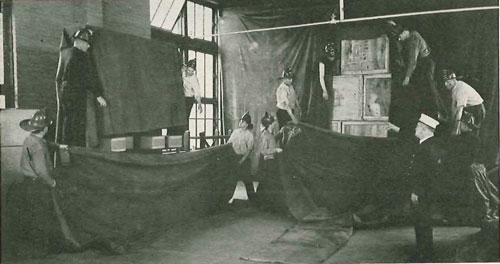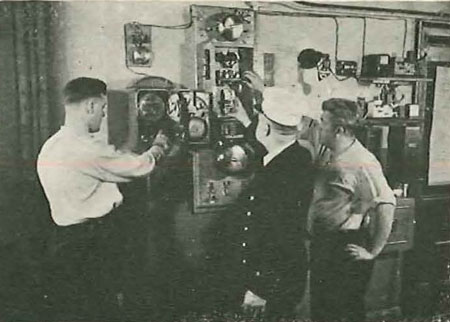
The New York Fire Patrol School, 1934: Throwing Covers
BY GLENN CORBETT
The art of “throwing covers” to protect endangered property during a fire evolved over many years in America’s cities. New York City created the first fire patrol in the 1800s – red-helmeted firefighters whose mission was to prevent water and fire damage to goods in commercial structures. Financed by the insurance industry, fire patrols (also called salvage corps) were created in dozens of cities across America.
Tom Brennan, the late Fire Engineering editor and Fire Department of New York (FDNY) captain, told me many years ago that the city’s fire patrolmen experienced the same dangers as FDNY firefighters and “died just as easily in a collapse as firefighters.” At the World Trade Center on 9/11, along with the 343 FDNY members murdered that day, Fire Patrolman Keith Roma also died while evacuating civilians. He is the forgotten number 344.
By the 1960s, fire patrols began to disappear from those same American cities. The last fire patrol in the United States – ironically in New York City, where it started more than 150 years earlier – was disbanded in 2006.
The excerpts below highlight the tools, techniques, and history of the now slowly disappearing fireground salvage function. When was the last time you “threw a cover”?
To download a PDF of the original article, access it online at http://emberly.fireengineering.com/archives.html.
Fire Engineering January 1936: Salvage as Taught by New York Fire Patrol
By WILLIAM JEROME DALY
The New York Fire Patrol School of Salvage Operations, now in its second year, is attracting the favorable attention of fire insurance underwriters as well as municipal fire officials throughout the country ….
[T]he enthusiastic Capt. William S. Cashman, of Fire Patrol No. 6, in the Bronx … has advocated it for years. Without expence to the New York Board of Fire Underwriters [the corps’ administrative authority], Capt. Cashman turned the top floor of the station of Fire Patrol No. 6 into a laboratory for the salvaging of property from fire and water ….
 |
| (1) At the New York Fire Patrol School of Salvage, Spreading Covers on Stock and Shelving. |
Six patrolmen attend daily for one week. They come from three of the nine stations in the city. Capt. Cashman is the instructor. The school has every conceivable prop, tool, appliance, apparatus, implement and physical condition that a salvage man is apt to meet. The only things absent are smoke, heat and flames. There is a complete stock of packing cases and crates of various sizes; household and office furniture, shelving, fixtures, etc.; a standard New York fire alarm telegraph street signal box; an engine house bell set with Morse key, etc.; an A.D.T. supervisory system, typical of the installations in commercial buildings; an Aero-automatic alarm system; a water tight room for sprinkler demonstration; a standard fire hydrant and a complete lay-out of tools, appliances, supplies, etc., used in salvage work ….
Each Fire Patrol truck in New York carries 35 covers. There are from 300 to 400 covers in reserve on the racks of each patrol station. Recently each station of the salvage corps was equipped with two new trucks, or wagons, as they are still referred to by fire fighters of the horse drawn era ….
How the Patrol Started
In old New York, in the days of the Volunteer Fire Department … [r]ivalry between volunteer fire companies was very keen and competition for distinction in fighting a fire, coupled with the excitement of the blaze, made it impossible for any but a special force to take necessary precautions for the protection of property from water and fire …. [T]he insurance companies … arranged, in 1803, with various members of the fire companies to make the preservation of materials, fixtures, furniture, etc., their particular responsibility. They called it the “firepolice” service.
The duties of this corps were so prescribed as not to bring them into conflict with the regular Fire Department, but rather to facilitate the work of the city’s firemen. The first Fire Patrol was known as the Mutual Bag Company …. [Each member] carried two bags made of Russian sheeting, or some equally serviceable cloth, three feet long and two feet wide, marked with the owner’s name and the initials of the organization. This outfit was inspected regularly every three months …. Any deficiency … was the subject of disciplinary action. The duties of the members were prescribed … as follows:
 |
| (2) Fire Alarm Telegraph and the A.D.T. Section of the School. Captain Cashman Making a Test. |
“Upon an alarm of fire every member with his hat and bags shall repair to the house or store most in danger, belonging to any member of the company, and endeavor to the utmost of his power to save their effects, by carefully conveying them to some convenient and proper place and to prevent the embezzlement of the same; and in case no such house or store be in danger, then each member shall give his assistance where he deems most proper.”
This service was voluntary and it was then, as it is now, wholly distinct from the regular Fire Department.
[In] 1835, the Association of Fire Insurance Companies employed four men at a salary of $250 a year each to “attend all fires and to protect the interests of the Fire Underwriters by preserving property exposed to fire and damage thereto by water.” This was the beginning of the fire patrol.
 |
| (3) Fire Patrolmen Are Taught and Must Practice All the Fire Department Telegraph Code Signals. |
…. In November, 1839, the association employed forty men as a Fire-Police Force for duty in the fifth fire district (mercantile section) as a night patrol …. The expense for the first year amounted to $17,927 ….
The men…were mostly former members of the Volunteer Fire Department …. The only uniform required … was a red fire hat …. The regular firemen [called them] “red heads.”
…. [In] 1853 the first code of rules was printed and placed in the hands of every member of the force …. The only apparatus of the company in those days consisted of a small hand drawn cart … stored on the top floor of a building during the day and at seven o’clock every evening it was lowered to the street and placed in service until five o’clock the following morning, when it was again hoisted to its top floor storage ….
The New York Fire Patrol in the year 1934 responded to 34,322 alarms and spread 32,436 covers …. The patrol trucks traveled a total of 83,384 miles. The net expense last year … was $564,201. Its members salvaged many hundreds of thousands of dollars worth of property from fire and water losses. Some of the patrolmen rescued men, women and children at the risk of losing their own lives.
Fire Engineering Archives

